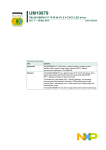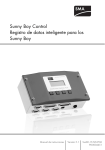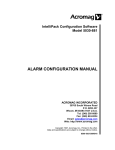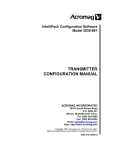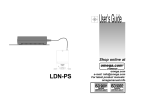Download 450 - Omega Engineering
Transcript
User’s Guide MADE IN 305.4 °F ® 450 AET THERMOCOUPLE THERMOMETER TYPE E Shop online at ON °F HOLD www.omega.com e-mail: [email protected] 1° 0.1° ON OFF °C TEMPERATURE INDICATOR 450 SERIES Digital Thermometers OMEGAnet ® On-Line Service www.omega.com Internet e-mail [email protected] Servicing North America: USA: ISO 9001 Certified Canada: One Omega Drive, Box 4047 Stamford CT 06907-0047 Tel: (203) 359-1660 e-mail: [email protected] 976 Bergar Laval (Quebec) H7L 5A1, Canada Tel: (514) 856-6928 e-mail: [email protected] FAX: (203) 359-7700 FAX: (514) 856-6886 For immediate technical or application assistance: USA and Canada: Mexico: Sales Service: 1-800-826-6342 / 1-800-TC-OMEGA® Customer Service: 1-800-622-2378 / 1-800-622-BEST® Engineering Service: 1-800-872-9436 / 1-800-USA-WHEN® TELEX: 996404 EASYLINK: 62968934 CABLE: OMEGA En Espan˜ol: (001) 203-359-7803 FAX: (001) 203-359-780 e-mail: [email protected] [email protected] Servicing Europe: Benelux: Postbus 8034, 1180 LA Amstelveen The Netherlands Tel: +31 (0)20 3472121 FAX: +31 (0)20 6434643 Toll Free in Benelux: 0800 0993344 e-mail: [email protected] Czech Republic: Frystatska 184, 733 01 Karvina´, Czech Republic Tel: +420 (0)59 6311899 FAX: +420 (0)59 6311114 Toll Free: 0800-1-66342 e-mail: [email protected] France: 11, rue Jacques Cartier 78280 Guyancourt, France Tel: +33 (0)1 61 37 2900 FAX: +33 (0)1 30 57 5427 Toll Free in France: 0800 466 342 e-mail: [email protected] Germany/Austria: Daimlerstrasse 26, D-75392 Deckenpfronn, Germany Tel: +49 (0)7056 9398-0 FAX: +49 (0)7056 9398-29 Toll Free in Germany: 0800 639 7678 e-mail: [email protected] United Kingdom: ISO 9002 Certified One Omega Drive River Bend Technology Centre Northbank, Irlam, Manchester M44 5BD United Kingdom Tel: +44 (0)161 777 6611 FAX: +44 (0)161 777 6622 Toll Free in United Kingdom:0800-488-488 e-mail: [email protected] It is the policy of OMEGA to comply with all worldwide safety and EMC/EMI regulations that apply. OMEGA is constantly pursuing certification of its products to the European New Approach Directives. OMEGA will add the CE mark to every appropriate device upon certification. The information contained in this document is believed to be correct, but OMEGA Engineering, Inc. accepts no liability for any errors it contains, and reserves the right to alter specifications without notice. WARNING: These products are not designed for use in, and should not be used for, human applications. RETURN REQUESTS/INQUIRIES Direct all warranty and repair requests/inquiries to the OMEGA Customer Service Department. BEFORE RETURNING ANY PRODUCT(S) TO OMEGA, PURCHASER MUST OBTAIN AN AUTHORIZED RETURN (AR) NUMBER FROM OMEGA’S CUSTOMER SERVICE DEPARTMENT (IN ORDER TO AVOID PROCESSING DELAYS). The assigned AR number should then be marked on the outside of the return package and on any correspondence. The purchaser is responsible for shipping charges, freight, insurance and proper packaging to prevent breakage in transit. FOR WARRANTY RETURNS, please have the following information available BEFORE contacting OMEGA: 1. Purchase Order number under which the product was PURCHASED, 2. Model and serial number of the product under warranty, and 3. Repair instructions and/or specific problems relative to the product. FOR NON-WARRANTY REPAIRS, consult OMEGA for current repair charges. Have the following information available BEFORE contacting OMEGA: 1. Purchase Order number to cover the COST of the repair, 2. Model and serial number of the product, and 3. Repair instructions and/or specific problems relative to the product. OMEGA’s policy is to make running changes, not model changes, whenever an improvement is possible. This affords our customers the latest in technology and engineering. OMEGA is a registered trademark of OMEGA ENGINEERING, INC. © Copyright 2003 OMEGA ENGINEERING, INC. All rights reserved. This document may not be copied, photocopied, reproduced, translated, or reduced to any electronic medium or machine-readable form, in whole or in part, without the prior written consent of OMEGA ENGINEERING, INC. Table of Contents Section 1: Description 1.1 General Description……………2 1.2 Physical Description…………...3 1.3 Unpacking……………………… 3 1.4 Specification…………………… 4 Section 2: Operation 2.1 Principles of Operation………...7 2.2 Power…………………………… 8 2.3 Operation……………………….10 2.4 Maintenance……………………13 Section 3: Calibration 3.1 Calibration………………………14 Section 1 Description 1.1 General Description Your hand-held, battery operated digital temperature indicator is configured for compatibility with one of five temperature transducers, J,K,E,T RTD and Thermister. Each of the configurations linearizes the analog output from the transducer to produce a stable and accurate digital temperature display. Plug-in type input connectors are used for the transducer input to provide quick connect and disconnect capability. The indicator functions are controlled by the keyboard. The liquid crystal display exhibits the value of the measurement, degrees Fahrenheit or Celsius, and the low battery voltage indication. The use of advanced digital design techniques give the indicator extremely accurate readings and exceptionally long battery life. 2 1.2 Physical Description The indicator measures 45 mm (1.8 inches) in Height, 85 mm (3.3 inches) in width, and 145 mm (5.7 inches) in length. Weight is 230 grams (8.0 ounces). The case is constructed of high impact plastic. 1.3 Unpacking The indicator is supplied with the battery installed. A quick electrical test should be performed to verify that the indicator is operative. See 2.3 in Section 2 for operating instructions. Contact our Instrument Repair Department immediately if any problems are observed after checking out operation of the unit. 3 Specifications Display: Liquid crystal display, 7.6 mm (0.3 in.) digit Height Operating temperature: 0 to 50°C (32 to 122°F) 0 to 75% Relative Humidity Storage Temperature: -20 to 70°C (-4 to 158°F) Battery: NEDA 1604, 9 Volt Battery Life: Thermocouple-2000 hours minimum Platinum RTD-500 hours minimum Thermistor- 1200 hours minimum NMRR: 50 dB @ 50±1 Hz, 0.1° range 35 dB @ 50±1 Hz or 60±1Hz, 1° range CMRR: 140 dB @ 50±1 Hz, 0.1° range 120 dB @ 50±1 Hz or 60±1Hz, 1° range 4 Maximum Common Mode Voltage: 1000VAC(RMS), ±2000V Peak Accuracy at 22°C (72°F) 1° range: ±0.8°C±0.1% rdg ±1.5°F±0.1% rdg ±0.25°C±0.1% rdg ±.45°F±0.1% rdg 0.1° range: Stability with time: 90 days: 1 year: add ±0.05% rdg. add ± 0.1% rdg. Stability with temperature: Thermocouple: zero: ±0.03°C/°C span: ±0.02% rdg/°C (max) reference junction tracking ±1.0°C (±1.8°F) from 5°C to 45°C (41°F to 113°F) Platinum RTD: ±0.02°C, ±0.01% rdg/°C Thermistor: positive- ±0.02°C/°C negative-±0.04°C/°C 5 450 Range Table Type K Type J Type E Type T -189 C to +1372 C -308 F to +2501 F -139.8 C to +203.7 C -219.7 F to +398.7 F -194 C to +1200 C -318 F to +2192 F -117.4 C to +203.5 C -179.4 F to +398.7 F -212 C to +1000 C -351 F to +1832 F -137.2 C to +203.5 C -215.0 F to +398.4 F -217 C to +400 C -360 F to +752 F -148.2 C to +203.9 C -234.8 F to +399.0 F -233 C to +904 C -388 F to +1660 F -102.9 C to +203.5 C -153.2 F to +398.3 F -25.7 C to +103.2 C -14.4 F to +217.8 F 1 0.1 1 0.1 1 0.1 1 0.1 1 RTD 0.1 Thermister 0.1 6 Section 2 Operation 2.1 Principles of Operation The temperature indicator uses two ICs to digitize and display the analog input signal. One IC performs the conversion of the analog input to the digital equivalent via 24 bit deltasigma analog to digital converter. Battery voltage is also monitored by this IC and a thermistor supplies the reference junction correction signal. The other IC receives input from the analog to digital converter, linearizes and drives the LCD display. Front panel buttons are also monitored. 7 2.2 Power When battery voltage reaches about 6 volts, the display will exhibit a flashing: “LOW BAT” indication. A minimum of 20 hours of operation time remains upon initial appearance of the “LOW BAT” indication. When the battery voltage drops below 5 volts, an overload indications of three columns of dashes will appear on the display in addition to the flashing “LOW BAT” symbol. The indicator uses a NEDA 1604 (or equivalent) 9 Volt battery. The battery will provide a minimum of 2000 hours of continuous thermocouple operation, 500 hours of RTD operation, or 1200 hours of thermistor operation. To replace the battery, follow these steps. Note: The indicator must be OFF when Replacing the battery. Step 1: Place the indicator face down on a flat surface and remove the four screws located in 8 the recesses or each corner of the case bottom. Step 2: Carefully pull the case halves straight apart so as not to damage the internal connectors. Step 3. Install the new battery. Close the case and reinstall the four screws. 9 2.3 Operation Step 1: Insert temperature sensor plug into the indicator input jack. Failure to insert a probe results in a overload condition of three columns of dashes showing on the display. Step 2: Turn the indicator ON by pressing the °F or °C key. The display can be switched to read the temperature in degrees Celsius or Fahrenheit without affecting calibration. Step 3: Select the display range of 1° (wide range, low resolution) or 0.1° (narrow range, high resolution) with the 1°/0.1° key. Note: The thermistor unit has a fixed resolution of 0.1°. Step 4: By pressing and holding the HOLD key, The last reading will be displayed as long as the hold key is depressed. After the hold key is released, the indicator will revert to its normal display mode. 10 Step 5: Observe and or record the temperature value. Step 6: Turn instrument off by pressing the OFF key. 11 Low Battery Voltage Indication Probe Input Jack Display Value F/C Indication F C To Hold Display Press and hold key to retain last reading on the display. 450 SERIES ON F . HOLD 1 0.1 Press this key to turn OFF ON C . OFF Range Selector Press C or F keys to turn ON and/or temperature scale Operation Features 12 2.4 Maintenance Normal maintenance of the indicator consists of occasional cleaning with a soft, damp cloth, replacement of the battery as required, and calibration as outlined in Section 3. 13 Section 3 Calibration 3.1 Calibration Units with serial numbers beginning with the letter N use the calibration procedure outlined below. Older units do not display version numbers and use the calibration procedures on page 19 . The calibration procedure should be performed by a qualified instrumentation service technician. The indicator may be brought to any instrumentation calibration and repair laboratory (metrology lab) for the service (this manual should accompany the instrument). This procedure should be done at least once a year to guarantee continued performance within the specification. The instrument should be calibrated at an ambient temperature of 22° C with a thermocouple simulator 14 with a minimum accuracy of ±0.1 degree Fahrenheit or ±0.2 degree Centigrade. Step 1. Ensure the unit is turned off. Connect the output of the thermocouple simulator to the input of the indicator using the appropriate thermocouple wire. Set the simulator output to 0°C Step 2. Locate the calibration switch on the back of the case labeled “Zero”. Remove the black button. Using a small screw drive or flat end of the trimmer pot, press the cal switch once. The display should read version and then switch to ambient temperature; press the switch one more time. The display should indicate .0.0 °C Step 3. Press the switch one more time, the display should read max calibration temperature (for K type: 13.2.0, for J type: 9.6.0, for T type: 3.5.0, and for E type: 9.5.0) Now, set the simulator output to display temperature as show in table below. 15 NOTE: If you want to cancel the calibration mode press OFF button in front of the unit. For T/C type K set simulator @ 1320 °C J set simulator @ 960 °C T set simulator @ 350 °C E set simulator @ 950 °C Press the switch one more time and wait for a few seconds until display switches to 0.0 set simulator to 0°C. Press switch one more time. Unit should shut-off. Step 4. Now, turn the unit on from front panel. Make sure the unit in degree C mode. Verify that the unit is within specification throughout its range. Step 5. If unit does not meet specification as 0°C then repeat calibration procedure, Instead of setting simulator as 0°C, set it at the temperature indicated by the unit in measurement mode as 0°C. For example in measure mode, unit may display .2°C with simulator as 0°C. During 16 calibration procedure, set simulator at .2°C instead of 0 °C. Repeat the calibration procedure again. Step 6. Verify calibration once finished. 17 Ra Rb Rc GND Ref J +IN -1.23V +3.7V 10 2 5 1 6 3 8 9 4 7 Ra - Full Scale Adj. Rb Zero Adj. Rc +Full Scale Adj. 18 Calibration- Thermocouple Type K, J and T and E Equipment List • • • • 4 ½ digit voltmeter Voltage Calibrator: Resolution, 1uV; accuracy ±0.01% (±2uV) Ice Bath, 0.00 °C ± 0.05°C Jumper lead terminated in mini-clips For optimum results, the calibration should be performed with an ambient temperature from 20° 24°C (68° to 75°F). Refer to the figure on the previous page for the locations of all testpoints and adjustments. a. Turn the indicator ON by pressing the °C key. b. For types K, J, E and T units only, switch the indicator to the 0.1° range. 19 c. d. Remove the bottom case of the indicator. Adjust the voltage calibrator for an output of 0.000mV and connect the minus lead from the calibrator to “GND” and the positive lead from the calibrator to “;+IN”, on the indicator printed circuit board. e. Disable the reference junction by jumpering together the “REF J” and “GND” testpoints, using a jumper lead terminated in mini-clips. f. Adjust Rb for an indicator display of 0.0°C. g. Connect the DVM LO lead to “GND”, on the indicator printed circuit board. h. Using HI lead of DVM, measure voltage at the “-1.23V” testpoint: disregarding polarity indication, record the voltage. i. Move the DVM HI lead to the “3.7V” testpoint and record the voltage (disregard 20 polrity). j. The voltage measured at the “3.7V” testpoint should be 3.007 times larger than the voltage measured at the “-1.23V” testpoint. Adjust Rc (which varies the +3.7V line to attain the proper ratio. k. Switch the indicator to the 1° range. l. Adjust the voltage calibrator for an output of +53.782mV for type K; +57.942mV for type J; +75.983mV for type E; +18.824mV for type T; m. Adjust Ra for an indicator display of +995°C for type E, or 1000°C for type J, or +1340°C for type K, or +367°C for type T. n. Reassemble the indicator. o. Perform the zero calibration. 21 Calibration- Thermistor Type Equipment List • • • • 4 ½ digit voltmeter Precision decade box: Resolution, 0.01 ohm ; accuracy ±0.02% Ice Bath, 0.00 °C ± 0.05°C Electro Scientific Industries DB-62 or equivalent a. Turn the indicator ON by pressing the °C key. b. Remove the bottom case of the indicator. c. Connect a precision resistance box to the terminals on the phone input jack; set the resistance box to 7,280 ohms. d. Connect the DVM LO lead to “GND”, on the indicator printed circuit board. e. Using HI lead of DVM, measure voltage 22 at the “-1.23V” testpoint: disregarding polarity indication, record the voltage. f. Move the DVM HI lead to the “3.7V” testpoint and record the voltage (disregard polarity). g. The voltage measured at the “3.7V” testpoint should be 3.007 times larger than the voltage measured at the “-1.23V” testpoint. Adjust Rc (which varies the +3.7V line to attain the proper ratio. h. Adjust Rb for an indicator display of 0.2°C. i. Set the resistance box to 148.4 ohms. j. Adjust Ra for an indicator display of +101.0°C. k. Reassemble the indicator. l. Perform the zero calibration 23 Calibration- Platinum RTD Equipment List • • • • • 4 ½ digit voltmeter Precision decade box: Resolution, 0.01 ohm ; accuracy ±0.02% Ice Bath, 0.00 °C ± 0.05°C Electro Scientific Industries DB-62 or equivalent a. Turn the indicator ON by pressing the °C key. b. Remove the bottom case of the indicator. c. Connect a precision resistance box to the terminals on the RTD input jack and set the resistance box to 100.04 ohms. d. Using HI lead of DVM, measure voltage at the “-1.23V” testpoint: disregarding polarity indication, record the voltage. 24 e. Move the DVM HI lead to the “3.7V” testpoint and record the voltage (disregard polrity). f. The voltage measured at the “3.7V” testpoint should be 3.007 times larger than the voltage measured at the “-1.23V” testpoint. Adjust Rc (which varies the +3.7V line to attain the proper ratio. g. Adjust Rb for an indicator display of 32.2°F. h. Adjust Ra for an indicator display of +196.0°C. i. Reassemble the indicator. Perform the zero calibration 25 Zero Calibration a. Turn the indicator on by pressing the °C key. b. Set the indicator to the 0.1° range. c. Connect the ice bath probe to the indicator Input jack. d. Place the probe in a stable ice bath (0.00C ±0.05°C and adjust the ZERO pot (Rb) located beneath the plug on the rear case for an indicator display of 0.0°C. e. Replace the rubber plug. Calibration is complete. 26 WARRANTY/DISCLAIMER OMEGA ENGINEERING, INC. warrants this unit to be free of defects in materials and workmanship for a period of 13 months from date of purchase. OMEGA’s Warranty adds an additional one (1) month grace period to the normal one (1) year product warranty to cover handling and shipping time. This ensures that OMEGA’s customers receive maximum coverage on each product. If the unit malfunctions, it must be returned to the factory for evaluation. OMEGA’s Customer Service Department will issue an Authorized Return (AR) number immediately upon phone or written request. Upon examination by OMEGA, if the unit is found to be defective, it will be repaired or replaced at no charge. OMEGA’s WARRANTY does not apply to defects resulting from any action of the purchaser, including but not limited to mishandling, improper interfacing, operation outside of design limits, improper repair, or unauthorized modification. This WARRANTY is VOID if the unit shows evidence of having been tampered with or shows evidence of having been damaged as a result of excessive corrosion; or current, heat, moisture or vibration; improper specification; misapplication; misuse or other operating conditions outside of OMEGA’s control. Components which wear are not warranted, including but not limited to contact points, fuses, and triacs. OMEGA is pleased to offer suggestions on the use of its various products. However, OMEGA neither assumes responsibility for any omissions or errors nor assumes liability for any damages that result from the use of its products in accordance with information provided by OMEGA, either verbal or written. OMEGA warrants only that the parts manufactured by it will be as specified and free of defects. OMEGA MAKES NO OTHER WARRANTIES OR REPRESENTATIONS OF ANY KIND WHATSOEVER, EXPRESS OR IMPLIED, EXCEPT THAT OF TITLE, AND ALL IMPLIED WARRANTIES INCLUDING ANY WARRANTY OF MERCHANTABILITY AND FITNESS FOR A PARTICULAR PURPOSE ARE HEREBY DISCLAIMED. LIMITATION OF LIABILITY: The remedies of purchaser set forth herein are exclusive, and the total liability of OMEGA with respect to this order, whether based on contract, warranty, negligence, indemnification, strict liability or otherwise, shall not exceed the purchase price of the component upon which liability is based. In no event shall OMEGA be liable for consequential, incidental or special damages. CONDITIONS: Equipment sold by OMEGA is not intended to be used, nor shall it be used: (1) as a “Basic Component” under 10 CFR 21 (NRC), used in or with any nuclear installation or activity; or (2) in medical applications or used on humans. Should any Product(s) be used in or with any nuclear installation or activity, medical application, used on humans, or misused in any way, OMEGA assumes no responsibility as set forth in our basic WARRANTY/ DISCLAIMER language, and, additionally, purchaser will indemnify OMEGA and hold OMEGA harmless from any liability or damage whatsoever arising out of the use of the Product(s) in such a manner. Where Do I Find Everything I Need for Process Measurement and Control? OMEGA…Of Course! Shop online at www.omega.com TEMPERATURE Thermocouple, RTD & Thermistor Probes, Connectors, Panels & Assemblies Wire: Thermocouple, RTD & Thermistor Calibrators & Ice Point References Recorders, Controllers & Process Monitors Infrared Pyrometers PRESSURE, STRAIN AND FORCE Transducers & Strain Gages Load Cells & Pressure Gages Displacement Transducers Instrumentation & Accessories FLOW/LEVEL Rotameters, Gas Mass Flowmeters & Flow Computers Air Velocity Indicators Turbine/Paddlewheel Systems Totalizers & Batch Controllers pH/CONDUCTIVITY pH Electrodes, Testers & Accessories Benchtop/Laboratory Meters Controllers, Calibrators, Simulators & Pumps Industrial pH & Conductivity Equipment DATA ACQUISITION Data Acquisition & Engineering Software Communications-Based Acquisition Systems Plug-in Cards for Apple, IBM & Compatibles Datalogging Systems Recorders, Printers & Plotters HEATERS Heating Cable Cartridge & Strip Heaters Immersion & Band Heaters Flexible Heaters Laboratory Heaters ENVIRONMENTAL MONITORING AND CONTROL Metering & Control Instrumentation Refractometers Pumps & Tubing Air, Soil & Water Monitors Industrial Water & Wastewater Treatment pH, Conductivity & Dissolved Oxygen Instruments M0099/0603































